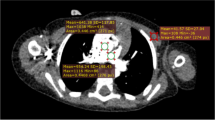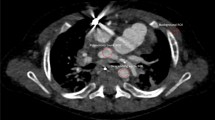Abstract
Background
There are a limited number of reports on the technical and clinical feasibility of prospective electrocardiogram (ECG)-gated multi-detector computed tomography (MDCT) in infants with congenital heart disease (CHD).
Objective
To evaluate image quality and radiation dose at weight-based low-dose prospectively gated 256-slice MDCT angiography in infants with CHD.
Materials and methods
From November 2009 to February 2010, 64 consecutive infants with CHD referred for pre-operative or post-operative CT were included. All were scanned on a 256-slice MDCT system utilizing a low-dose protocol (80 kVp and 60–120 mAs depending on weight: 60 mAs for ≤3 kg, 80 mAs for 3.1–6 kg, 100 mAs for 6.1–10 kg, 120 mAs for 10.1–15 kg).
Results
No serious adverse events were recorded. A total of 174 cardiac deformities, confirmed by surgery or heart catheterization, were studied. The sensitivity of MDCT for cardiac deformities was 97.1%; specificity, 99.4%; accuracy, 95.9%. The mean heart rate during scan was 136.7 ± 14.9/min (range, 91–160) with a corresponding heart rate variability of 2.8 ± 2.2/min (range, 0–8). Mean scan length was 115.3 ± 11.7 mm (range, 93.6–143.3). Mean volume CT dose index, mean dose-length product and effective dose were 2.1 ± 0.4 mGy (range, 1.5–2.8), 24.7 ± 5.9 mGy·cm (range, 14.7–35.8) and 1.6 ± 0.3 mSv (range, 1.1–2.5), respectively. Diagnostic-quality images were achieved in all cases. Satisfactory diagnostic quality for visualization of all/proximal/distal coronary artery segments was achieved in 88.4/98.8/80.0% of the scans.
Conclusion
Low-dose prospectively gated axial 256-slice CT angiography is a valuable tool in the routine clinical evaluation of infants with CHD, providing a comprehensive three-dimensional evaluation of the cardiac anatomy, including the coronary arteries.





Similar content being viewed by others
References
Burch GH, Sahn DJ (2001) Congenital coronary artery anomalies: the pediatric perspective. Coron Artery Dis 12:605–616
Mawson JB (2002) Congenital heart defects and coronary anatomy. Tex Heart Inst J 29:279–289
Goo HW, Seo DM, Yun TJ et al (2009) Coronary artery anomalies and clinically important anatomy in patients with congenital heart disease: multislice CT findings. Pediatr Radiol 39:265–273
Goo HW, Park IS, Ko JK et al (2005) Computed tomography for the diagnosis of congenital heart disease in pediatric and adult patients. Int J Cardiovasc Imaging 21:347–365, discussion 367
Dogan OF, Karcaaltincaba M, Yorgancioglu C et al (2007) Demonstration of coronary arteries and major cardiac vascular structures in congenital heart disease by cardiac multidetector computed tomography angiography. Heart Surg Forum 10:E90–E94
Lee T, Tsai IC, Fu YC et al (2007) MDCT evaluation after closure of atrial septal defect with an Amplatzer septal occluder. AJR Am J Roentgenol 188:W431–W439
Ou P, Celermajer DS, Calcagni G et al (2007) Three-dimensional CT scanning: a new diagnostic modality in congenital heart disease. Heart 93:908–913
Tsai IC, Lee T, Chen MC et al (2007) Gradual pulmonary artery enhancement: new sign of septal defects on CT. AJR Am J Roentgenol 188:1660–1664
Spevak PJ, Johnson PT, Fishman EK (2008) Surgically corrected congenital heart disease: utility of 64-MDCT. AJR Am J Roentgenol 191:854–861
Tsai IC, Chen MC, Jan SL et al (2008) Neonatal cardiac multidetector row CT: why and how we do it. Pediatr Radiol 38:438–451
Bardo DM, Asamato J, Mackay CS et al (2009) Low-dose coronary artery computed tomography angiogram of an infant with tetralogy of fallot using a 256-slice multidetector computed tomography scanner. Pediatr Cardiol 30:824–826
Schroeder S, Achenbach S, Bengel F et al (2008) Cardiac computed tomography: indications, applications, limitations, and training requirements: report of a Writing Group deployed by the Working Group Nuclear Cardiology and Cardiac CT of the European Society of Cardiology and the European Council of Nuclear Cardiology. Eur Heart J 29:531–556
Goo HW, Suh DS (2006) Tube current reduction in pediatric non-ECG-gated heart CT by combined tube current modulation. Pediatr Radiol 36:344–351
Hollingsworth CL, Yoshizumi TT, Frush DP et al (2007) Pediatric cardiac-gated CT angiography: assessment of radiation dose. AJR Am J Roentgenol 189:12–18
Herzog C, Mulvihill DM, Nguyen SA et al (2008) Pediatric cardiovascular CT angiography: radiation dose reduction using automatic anatomic tube current modulation. AJR Am J Roentgenol 190:1232–1240
Arnoldi E, Johnson TR, Rist C et al (2009) Adequate image quality with reduced radiation dose in prospectively triggered coronary CTA compared with retrospective techniques. Eur Radiol 19:2147–2155
Ben Saad M, Rohnean A, Sigal-Cinqualbre A et al (2009) Evaluation of image quality and radiation dose of thoracic and coronary dual-source CT in 110 infants with congenital heart disease. Pediatr Radiol 39:668–676
Blankstein R, Shah A, Pale R et al (2009) Radiation dose and image quality of prospective triggering with dual-source cardiac computed tomography. Am J Cardiol 103:1168–1173
Kuettner A, Gehann B, Spolnik J et al (2009) Strategies for dose-optimized imaging in pediatric cardiac dual source CT. Rofo 181:339–348
Pflederer T, Rudofsky L, Ropers D et al (2009) Image quality in a low radiation exposure protocol for retrospectively ECG-gated coronary CT angiography. AJR Am J Roentgenol 192:1045–1050
Lell M, Marwan M, Schepis T et al (2009) Prospectively ECG-triggered high-pitch spiral acquisition for coronary CT angiography using dual source CT: technique and initial experience. Eur Radiol 19:2576–2583
Tsai IC, Lee T, Chen MC et al (2007) Visualization of neonatal coronary arteries on multidetector row CT: ECG-gated versus non-ECG-gated technique. Pediatr Radiol 37:818–825
Goo HW, Park IS, Ko JK et al (2005) Visibility of the origin and proximal course of coronary arteries on non-ECG-gated heart CT in patients with congenital heart disease. Pediatr Radiol 35:792–798
Klass O, Jeltsch M, Feuerlein S et al (2009) Prospectively gated axial CT coronary angiography: preliminary experiences with a novel low-dose technique. Eur Radiol 19:829–836
Jin KN, Park EA, Shin CI et al (2010) Retrospective versus prospective ECG-gated dual-source CT in pediatric patients with congenital heart diseases: comparison of image quality and radiation dose. Int J Cardiovasc Imaging 26(Suppl 1):63–73
Cheng Z, Wang X, Duan Y et al (2010) Low-dose prospective ECG-triggering dual-source CT angiography in infants and children with complex congenital heart disease: first experience. Eur Radiol 20:2503–2511
Paul JF, Rohnean A, Elfassy E et al (2010) Radiation dose for thoracic and coronary step-and-shoot CT using a 128-slice dual-source machine in infants and small children with congenital heart disease. Pediatr Radiol 41:244–249
Goo HW, Yang DH (2010) Coronary artery visibility in free-breathing young children with congenital heart disease on cardiac 64-slice CT: dual-source ECG-triggered sequential scan vs. single-source non-ECG-synchronized spiral scan. Pediatr Radiol 40:1670–1680
Walker MJ, Olzsewki ME, Desai MY (2009) New radiation dose saving technologies for 256-slice cardiac computed tomography angiography. Int J Cardiovasc Imaging 25(Suppl 2):189–199
Tsai IC, Lee T, Chen MC et al (2007) Homogeneous enhancement in pediatric thoracic CT aortography using a novel and reproducible method: contrast-covering time. AJR Am J Roentgenol 188:1131–1137
Thomas KE, Wang B (2008) Age-specific effective doses for pediatric MSCT examinations at a large children’s hospital using DLP conversion coefficients: a simple estimation method. Pediatr Radiol 38:645–656
Goo HW (2010) State-of-the-art CT imaging techniques for congenital heart disease. Korean J Radiol 11:4–18
Jelnin VCJ, Muneer B (2006) Three dimensional CT angiography for patients with congenital heart disease: scanning protocol for pediatric patients. Catheter Cardiovasc Interv 67:120–126
Cademartiri F, Mollet NR, Lemos PA et al (2006) Higher intracoronary attenuation improves diagnostic accuracy in MDCT coronary angiography. AJR Am J Roentgenol 187:W430–W433
Acknowledgements
This work was partly financially supported by Science and Technology Planning Project of Guangdong Province (2009B030801257, 2006B36030026), Science and Technology Planning Project of Guangzhou City (2006Z3-E241) and scientifically supported by Philips Healthcare.
Author information
Authors and Affiliations
Corresponding author
Rights and permissions
About this article
Cite this article
Huang, Mp., Liang, Ch., Zhao, Zj. et al. Evaluation of image quality and radiation dose at prospective ECG-triggered axial 256-slice multi-detector CT in infants with congenital heart disease. Pediatr Radiol 41, 858–866 (2011). https://doi.org/10.1007/s00247-011-2079-2
Received:
Revised:
Accepted:
Published:
Issue Date:
DOI: https://doi.org/10.1007/s00247-011-2079-2




